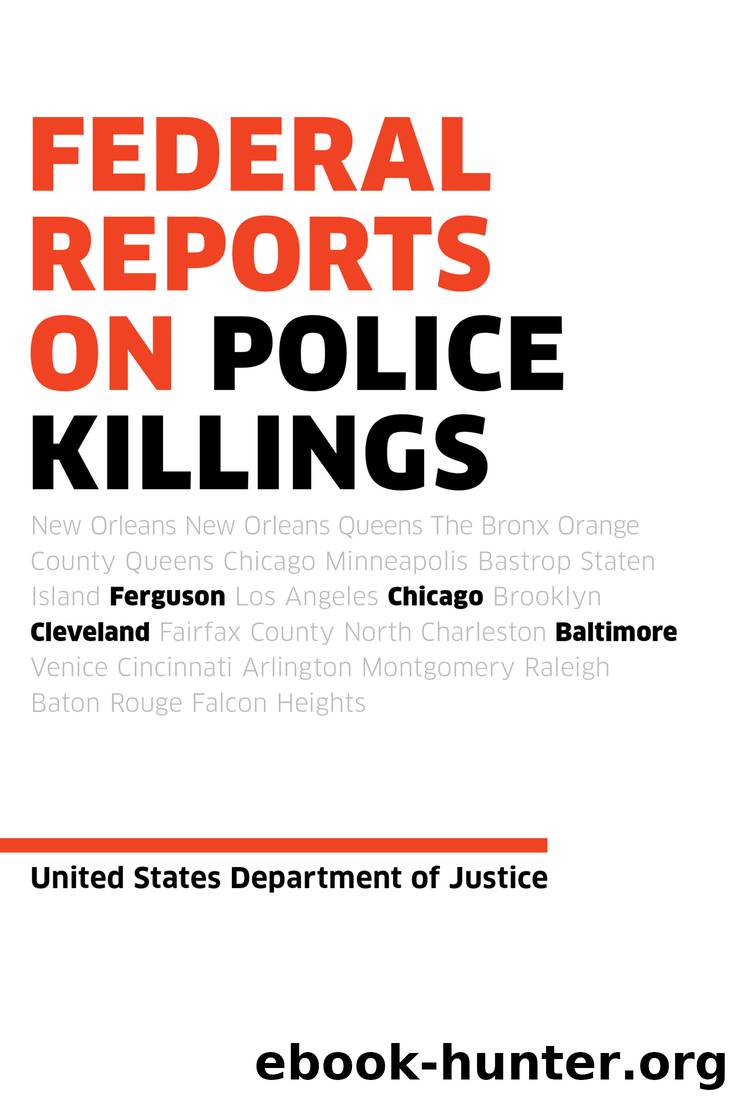Federal Reports on Police Killings by U.S. Department of Justice

Author:U.S. Department of Justice
Language: eng
Format: epub
Publisher: Melville House
Published: 2017-06-26T16:00:00+00:00
ii. BPD’s Deadly Force Investigations Lack Critical Analysis and Information that is Necessary to Evaluate the Threat Faced and Force Used
Like its chain of command investigations, BPD’s investigations of officers’ use of deadly force, including officer-involved shootings, lack critical information needed to evaluate the propriety of the force, reflect a bias in favor of involved officers, and include unreasonable delays. This is concerning, as “[t]he intrusiveness of a seizure by means of deadly force is unmatched. The suspect’s fundamental interest in his own life need not be elaborated upon. The use of deadly force also frustrates the interest of the individual, and of society, in judicial determination of guilt and punishment.” Garner, 471 U.S. at 9. Officers’ uses of deadly force must be critically examined to ensure that they conform with the Department’s policies and law. Even when the use of deadly force is justified, much can be learned by critically examining incidents to improve tactics and lessen the need to use such force.
In our investigation, we requested investigative files for all deadly force incidents, including all officer-involved shootings, between January 1, 2010 and May 1, 2016. Troublingly, BPD informed us that they could not locate the investigative files for twenty officer-involved shootings that occurred in that timeframe, and could provide no explanation for their absence. These included lethal shootings of members of the public, including one lethal shooting, as well as firearms discharges against animals and unintentional discharges. Failing to maintain files of such high risk incidents is a serious omission, inhibiting effective oversight and eroding public confidence that BPD takes seriously its responsibility to oversee its own use of force.
Our review of BPD deadly force investigations revealed many of the same problems that were present in the chain of command investigations. Transcripts of interviews were routinely excluded, and it appears that they were not created in many cases. Inconsistencies between witness accounts, officer statements, and physical evidence were frequently not investigated. Moreover, documents and evidence that one would expect to see in an administrative investigation of an officer-involved shooting, such as crime scene logs, photographs of the subject or the scene, and crime lab reports, were frequently missing from the investigative files we reviewed. As in the chain of command investigations, we saw evidence that involved officers conferred with other involved and witnessing officers about the incident before speaking with investigators. Investigators also failed to question officers about their conduct before the shooting, to ascertain—even if the shooting was lawful—what tactical, training or other issues could be identified.
We also found that significant delays in BPD’s deadly force investigations diminished the integrity of the investigations. As a matter of practice, BPD investigators do not interview officers who discharge their weapons until after the State’s Attorney’s Office issues a letter declining to prosecute the officer for any potential criminal act. Often, the State’s Attorney’s Office takes many months, and in a number of cases, over a year, to determine whether to prosecute, and, if not, to issue a declination letter.
Download
This site does not store any files on its server. We only index and link to content provided by other sites. Please contact the content providers to delete copyright contents if any and email us, we'll remove relevant links or contents immediately.
| Anthropology | Archaeology |
| Philosophy | Politics & Government |
| Social Sciences | Sociology |
| Women's Studies |
Nudge - Improving Decisions about Health, Wealth, and Happiness by Thaler Sunstein(7255)
iGen by Jean M. Twenge(5166)
The Fire Next Time by James Baldwin(5024)
Adulting by Kelly Williams Brown(4239)
The Hacking of the American Mind by Robert H. Lustig(4092)
The Sports Rules Book by Human Kinetics(4079)
The Ethical Slut by Janet W. Hardy(4042)
Captivate by Vanessa Van Edwards(3732)
Mummy Knew by Lisa James(3522)
In a Sunburned Country by Bill Bryson(3374)
The Worm at the Core by Sheldon Solomon(3327)
Ants Among Elephants by Sujatha Gidla(3282)
Suicide: A Study in Sociology by Emile Durkheim(2908)
The Slow Fix: Solve Problems, Work Smarter, and Live Better In a World Addicted to Speed by Carl Honore(2843)
The 48 laws of power by Robert Greene & Joost Elffers(2816)
Humans of New York by Brandon Stanton(2690)
Handbook of Forensic Sociology and Psychology by Stephen J. Morewitz & Mark L. Goldstein(2605)
The Happy Hooker by Xaviera Hollander(2586)
The Tipping Point by Malcolm Gladwell(2563)
